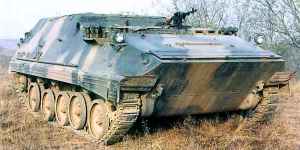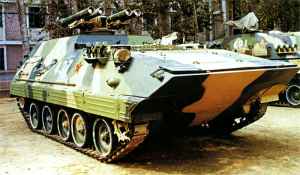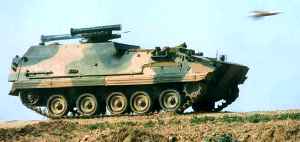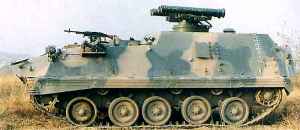| Designation: | ZDF89 |
 |
|---|---|---|
| Manufacturer: | NORINCO - China North Industries Group Corporation - CNGC | |
| Product type: | Armoured Vehicles | |
| Name: | Self-propelled guided missile system |
The ZDF89 (also known as Type 89; industrial designation: YW534) is a mobile anti-armour weapon system using the HongJian-8 (HJ-8) semi-active, wire-guided anti-tank guided missile (ATGM) launcher and guidance system, mounted on a modified ZSD89 (Type 89) armoured personnel carrier (APC). The ADF89 can accompany main battle tanks and armoured fighting vehicles on the battlefield to provide a highly mobile, armour protected anti-armour firepower.
Following the introduction of the first-generation manually-operated ATGM HJ-73 in the late 1970s, NORINCO began to develop China’s second-generation semi-active ATGM HJ-8. At the same time, the PLA demanded the missile to be carried onboard a mobile platform that can manoeuvre along with the armoured forces on the battlefield. Several truck-mounted designs were developed but they lacked necessary armour protection for the weapon system and its crew, making them highly vulnerable in modern land warfare.
201 Institute (now China North Vehicle Research Institute, NEVORI) of NORINCO adopted an alternative approach by incorporating the ATGM system with a tracked armoured vehicle. An concept demonstration example based on a Type 63 (YW531) APC carrying a single HJ-8 ATGM launcher was produced in December 1982. The results of extensive road and missile firing tests on the vehicle indicated that the design was feasible. In November 1985, 201 Institute produced a second prototype featuring a four-tube launcher turret for the approval of the military authority.
The HJ-8 ATGM carrier design was approved for engineering development in May 1986. At the same time, the PLA demanded the chassis to be replaced by a more advanced Type 89 (YW534) APC and the missile turret to be replaced by a hydraulic-powered elevation weapon station. The first prototype was produced in October 1987. The vehicle was then tested for long distance travelling, missile firing, and adaptability to extreme low temperatures. Based on the test results, two modified production prototypes were produced and delivered to the PLA for design finalisation trial in April 1988. The vehicle received its design certificate in July 1990 and was officially designated ZDF89.
The ZDF89 is similar to the ZSD89 APC in appearance, apart from the raised troop compartment to accommodate the elevation weapon station. The vehicle has a four-man crew, including commander, driver, weapon operator, and loader. The engine compartment is located at the right front of the hull. The driver is seated at the left front with the commander sitting directly behind him. The elevation weapon station and the weapon operator seat are located in the middle of the vehicle to the left. The loader is seated at the rear of the vehicle, where the spare missiles are stored. The crew are protected by a collective NBC protection system in the pressurised and filtered hull.
The vehicle has an integrated weapon station containing an observation/fire-control unit and four tube missile launchers. When the vehicle is in travelling mode, the station can be retracted back to inside the troop compartment. There are four ready-to-launch missiles on the weapon station and eight spare missiles carried inside the hull. The station has an elevation from +10 to -10 degrees with +/-200 degree traverse. The weapon operator sits in the troop compartment with the loader when travelling, and enters the combat compartment when the weapon station is raised to the launch position. To avoid the damage by the missile rocket thrust and flare during launch, the missile launch mechanism is automatically locked unless all hatches and observation ports are shut.
The HJ-8 is a command to line of sight, semi-active homing, wire-guided missile launched from a tube launcher. The missile has a short, round body with a half-ball nose and foldable stabilising fins at missile’s tail. The missile has a minimum range of 100m and a maximum range of 3,000m. The missile’s high-explosive anti-tank (HEAT) warhead can penetrate 180mm armour angled at 68 degrees. The missile system can operate in temperatures between -40°C ~ +50°C. After all four missiles have been launched, the weapon station is lowered into the troop compartment for reloading.
The weapon operator search and locate the target using a periscope optical sight (7km range). Once the missile is launched, the operator continues aiming its sight at the target. The TV ganiometer measures the angle deviation between the missile and the line of sight. The correction command is sent to the missile via the wire. During the flight of the missile, the weapon operator only needs to keep the sight's cross-hair on the target, and the system automatically transmits the command signal to the missile until it hits the target. Early variants of the ZDF89 lacked the night vision for all-weather, day/night capability, though this may have been improved on later variants.
Secondary weapon includes a 7.62mm machine gun mounted on the commander cupola and two four-barrel smoke-grenade launchers mounted on both sides of the vehicle.
 |
 |
 |
 |